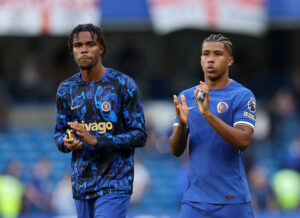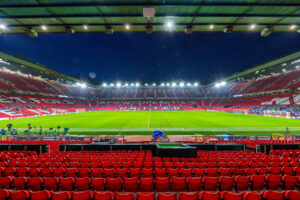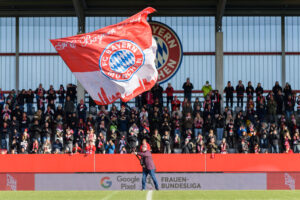Why has this World Cup gone so wrong for Argentina and Messi?
After Argentina and Messi’s humiliating 3-0 defeat to Croatia last week, it appeared their World Cup was already over. Although Nigeria’s victory over Iceland has kept their hope alive going into the final group game, Jorge Sampaoli’s men have been embarrassed so far in Russia. Last Word on Football has a closer look at why it’s gone so wrong for one of the pre-tournament favourites.
Manager/System
When Jorge Sampaoli was appointed in May 2017, he quickly made changes to emulate the high press, attacking football his Chile side had played with success. The Argentina Football Association had pursued Sampaoli previously, the manager turning down the job shortly after joining Sevilla. He managed to turn around Argentina’s poor start to World Cup qualifying, finishing in third place.
Sampaoli has adopted the mentality of his Chile predecessor Marcelo Bielsa. Favouring 3 at the back, his system relies on winning the ball back high up the pitch by pressing. The suffocating approach aims to force mistakes and when performed correctly can be devastating. However, many of the Argentines aren’t familiar with this system and the result has been a disjointed performance. For this reason, he opted for a 4-2-3-1 against Iceland, but reverted back to his preferred 3-4-2-1 for the Croatia game.
Against Croatia, Argentina provided minimal pressure up the pitch and appeared clueless when on the ball. Despite lacking the positives of the system, Argentina remained defensively vulnerable. The 3 man defence of Otamendi, Mercado and Tagliafico looked completely exposed, often outnumbered by Croatia’s counter attack. Of the 3, Otamendi is the only true centre back, and all have appeared uncomfortable in their roles.
The formation is heavily reliant on wing-backs, much like England have effectively used so far in this tournament. With none in the squad, Sampaoli has used wingers in these positions. Against Croatia, Eduardo Salvio and Marcos Acuna did nothing to support their back 3 whilst offering very little going forward.
Sampaoli’s passionate belief in his philosophy is understandable, having achieved so much elsewhere. However, with Argentina, he appears to be putting square pegs in round holes and he must adapt if they are to stand a chance of escaping the group.
Lack of Central Midfielders
Sampaoli’s system also puts a lot of expectation on the 2 men playing in central midfield. They are expected to shield the defence whilst also getting forwards to support Messi et al. However, against Croatia they appeared overwhelmed when being run at; Croatia’s exceptional midfield too quick, clever and talented for them.
Part of the problem is the lack of depth at the position. Javier Mascherano has deteriorated significantly in the last 12 months. Age has now caught up with the 34-year-old and he has been off the pace in Russia. Barcelona saw this decline, Mascherano only making 7 appearances this season before moving to China’s Hebei China Fortune. Despite the obvious warning signs, Sampaoli has kept faith in the midfielder, who has played in every minute of the tournament so far.
Much of this may be due to the lack of alternatives. Lucas Biglia and Enzo Perez have both started a game apiece so far at the tournament, but neither has made a positive impression. Biglia started throughout the majority of qualification, but a fractured vertebra sustained in April left him struggling for match fitness. Perez, meanwhile, struggled to start consistently for River Plate this season and was only called up after Manuel Lanzini was ruled out through injury. Surprisingly, Ever Banega has yet to start a game. The most creative of the 4, Banega played under Sampaoli at Sevilla and was expected to start at the tournament.
Reliance on Messi
To say that the Argentina side depends on Lionel Messi would be an understatement. During qualifying, only 3 other members of the World Cup squad scored more than once (Angel Di Maria, Christian Pavos and defender Gabriel Mercado). Messi’s tally of seven was vital, including his hat-trick in the final game against Ecuador in order to drag his side into the four qualifying spots. Defeat in that game would have seen Argentina fail to even reach the play-offs.
The lack of support from his fellow attackers is baffling. Sergio Aguero, Gonzalo Higuain and Paulo Dybala combined to score 74 goals for club this season yet shared only one goal in qualifying. Critics of Messi argue that this is because he is difficult to play with or that his greed restricts opportunities for his teammates. However, his Barcelona teammates don’t seem to have the same problems.
Against Croatia, Aguero only had seven first half touches. Whilst this was partly due to Croatia dominating possession, Aguero’s movement was sluggish and he cut the disinterested figure. Higuain, who replaced Aguero after the first goal, offered little different. Despite having an abundance of attacking talent, Argentina’s forwards aren’t doing enough to involve themselves. When Messi is drawing the attention of several defenders, the forwards should have more space to exploit. However, their movement is predictable and they have failed to do so.
One player whose lack of playing time has surprised is Dybala, a more mobile option. Thriving off of running at defenders and occupying space, Dybala should be able to drift into areas left vacant by opponents closing Messi down. With only 22 minutes of play over the two games to date, he has had minimal opportunity. With Aguero expected to be dropped against Nigeria, Dybala may finally get his chance.
The Sorry State of the Argentina Primera Division
The Argentine Primera Division was once a deep pool for the national team manager to pick from. However, the sale of young talent to Europe and a return of journeyed veterans have seen this number dwindle. Four of Argentina’s squad play their football in the country. Whilst this is relatively unchanged from the six of 2010 and three of 2014, the quality of play in the league has dropped.
This is highlighted by the poor recent performances of the Under 20 (U20) national side. The team, made up of almost entirely of Primera players, has a long history of success. Between 2001 and 2007, the side won the competition three times and came fourth once. Since then, the side have failed to qualify twice, suffered elimination in the first round twice and reached the quarter-finals only once. Five of the current World Cup squad played in the last victory in 2007 and Argentina have a proud tradition of bringing players into the first team from the successful U20 side. The drop in quality of this team reflects the shrinking national pool.
The export of young talent contributes to the U20 side’s struggles. Every season, the top performers are the subject of a big money move to Europe as owners look to cash in on their prize assets; Lautaro Martinez, Marcelo Saracchi and Maximiliano Romero are the latest to make the switch. Meanwhile, Argentina based Christian Pavos has been linked with a move to Tottenham and Maximiliano Meza will also be targeted. The result means that the quality of players left in the Primera Divison is lower, limiting the development of young talent. Furthermore, the departing players often find their progress dwindles due to limited game time abroad.
Conclusion
This Argentina side have several generational talents and should still qualify from the group stage. However, if they are to make a deep run into the competition then Sampaoli must be adaptable. His side need to be more defensively robust which may mean switching to a back four. Lionel Messi will always be targeted and Argentina must find ways to get their other stars involved.
Main image:






